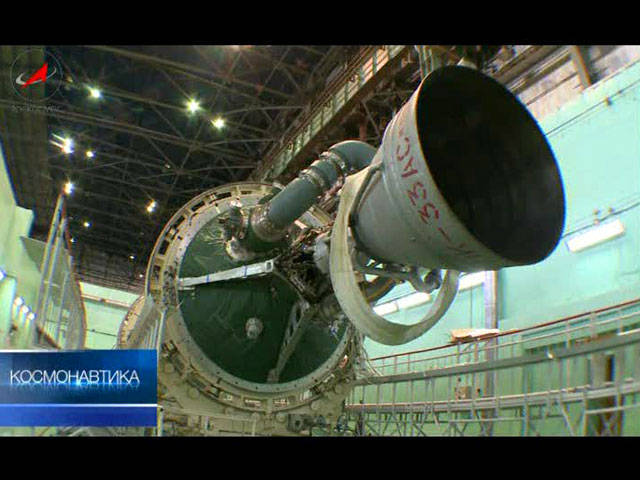Addition to the family of "Unions"

The famous intercontinental rocket R-7 in various modifications stayed in service for only ten years. But thanks to a very successful design and excellent modernization potential, it did not get lost in stories, but became the progenitor of a whole family of launch vehicles for spacecraft.
 Designers constantly improved the design, installed new engines and equipment in accordance with current requirements. But by the end of the 90s of the last century, some doubts began to appear. The development of telecommunications and other industries using artificial satellites required regular launches. But for the economic reasons, the same "Union" could only launch "parties" for several vehicles. The shortage of cargo increased the already considerable cost of putting it into orbit.
Designers constantly improved the design, installed new engines and equipment in accordance with current requirements. But by the end of the 90s of the last century, some doubts began to appear. The development of telecommunications and other industries using artificial satellites required regular launches. But for the economic reasons, the same "Union" could only launch "parties" for several vehicles. The shortage of cargo increased the already considerable cost of putting it into orbit.Arms reduction agreements prompted the idea not to dispose of intercontinental missiles taken from duty, but to use them as launch vehicles. In the spring of 1999, the first launch of the Dnepr carrier, created on the basis of the P-36M ICBM (according to the NATO SS-18 Satan classification), was made. Since then, Dnepr has sent more than fifty different vehicles into space. It took 17 start-ups, of which only one ended in an accident.
But such reforging of bayonets on plowshares was only half measure. All the same, a specialized launch vehicle was needed to launch cargo of small mass.
The development of such a rocket was launched at TsSKB-Progress in the early 2000-x. The rocket "Soyuz-2" was taken as a basis. The new launch vehicle was called the Soyuz-2 stage 1В or simply the Soyuz-2-1В.
To reduce weight and improve the economic "parameters", it was decided to abandon the side blocks of the first stage. It can be said, a bold decision for domestic rocket production. In this case, the remaining central unit was increased in size to accommodate all the necessary components and assemblies. Like previous Soyuz-2 series rockets, the 1В Stage received a new digital control system developed by the NPO Avtomatika.
The NK-33 was selected as the first stage propulsion engine. This single-chamber engine was developed in SNTK them. N.D. Kuznetsova based on the engine NK-15, used on the "lunar rocket" H-1. NK-33 is made according to the closed cycle scheme, works on the “traditional” fuel binder of kerosene-oxygen and is designed for the operating time in 365 seconds. The thrust developed by the engine at sea level is 154 tf, in a vacuum - 171 tf. There is no engine for taxiing: for this purpose, the RD-2 engines are used in the first stage of Soyuz-1-0110В.
The second stage is a propulsion RD-0124 engine developed by the Voronezh Khimavtomatika design bureau, specially created for the Soyuz-2 family of missiles. It is capable of producing thrust in 300 tf for 30 seconds.
With a launch mass of up to 160 tons, the Soyuz-2-1В rocket can launch into a low reference orbit up to 2850 kilograms of payload. For comparison, Dnipro raises tons to 3,7, however, it has more stringent restrictions on the dimensions of the cargo sent to space due to the silo launcher. The launch of the Soyuz-2-1В can be carried out from any launch pad compatible with the P-7 family of rockets after the installation of a number of specific equipment.
It is also possible to use the Soyuz-2-1B launch vehicle from the Volga launching unit. In this case, the payload is reduced to one and a half tons, but the height of the available orbit increases significantly.
In September of this year, tests of a new rocket began at the Samara plant TsSKB-Progress. At the time of this writing, the test of the design of Soyuz-2-1В was in full swing. Various units - engines, fuel tanks, automation, etc. - on a special stand is subjected to shaking and overload. The task of these tests is to identify the existing weak points in the design and correct these shortcomings in time. The fact is that from the workshop of the Samara plant to the cosmodrome, the rocket blocks are transported by rail, and this transport has its own characteristics - vibrations, shaking, etc.
After checking the individual units will experience the entire rocket. To do this, there is a special unit that simulates a railway transport platform on which the rocket will be taken to the launch. Soyuz-2-1B must endure 100 hours of such tests.
If everything goes well and no significant and lengthy improvements are needed, the new launch vehicle will go on the first flight this winter. The whole year of flight tests is also planned for the next year.
It is planned to put Soyuz-2-1В into operation in 2013-14. Launches of the new "Union" will be held at the Plesetsk cosmodrome, and possibly from Baikonur.
Information